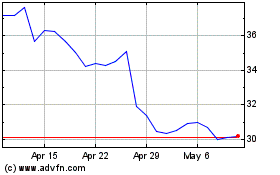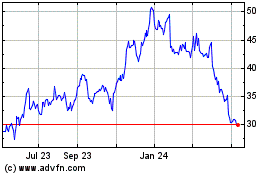By Ted Greenwald
This article is being republished as part of our daily
reproduction of WSJ.com articles that also appeared in the U.S.
print edition of The Wall Street Journal (June 25, 2018).
Intel Corp.'s next chief executive will take over the Silicon
Valley chip giant just as it is falling behind in the expensive
race to shrink the circuitry on silicon chips.
Intel's continuing problems manufacturing its next generation of
chips are opening the door for rivals to threaten its near-monopoly
in the personal-computer and server markets.
Intel is looking for a successor to Brian Krzanich, who resigned
last week for violating company policy by having a relationship
with a co-worker, which The Wall Street Journal on Friday reported
began before he became CEO.
Intel under Mr. Krzanich's watch has repeatedly missed its
schedule for shipping significant quantities of its next-generation
chips. The effort has been mired in manufacturing troubles, with
too few chips coming off production lines working properly, the
company said in April.
Taiwan Semiconductor Manufacturing Co., which makes chips for
Intel's chief rivals, is expected to ship new chips this year that
technical and financial analysts say will bear tiny transistors of
a size comparable to the next-generation chips Intel has delayed
into 2019. Smaller transistors allow chip makers to pack circuitry
more densely, making for more powerful chips that potentially are
also smaller and use less electricity.
That would mark the first time in Intel's five-decade history
that another manufacturer has beaten it to the broader market with
comparable chip-making technology, several analysts said. TSMC has
said it expects 20% of its revenue to come from its own next
generation in the fourth quarter.
The delays left some Intel engineers unhappy with Mr. Krzanich's
leadership, a person familiar with the situation said. The problems
not only delayed the manufacturing upgrade but they also could
force Intel to scrap new products based on it, the person said.
Every day, "we have to start thinking about, does this part fall
off the road map?" the person said.
"Our continued strong performance is the result of very
competitive products," Intel said, noting its ability to optimize
its current manufacturing process and improve its designs and
assembly techniques. "We intend to lead in all of these areas as we
expand into new opportunities."
In April, Mr. Krzanich acknowledged manufacturing problems,
telling analysts the company was delivering its next-generation
chips but in low volume. He said Intel understands the problem and
is working to fix it, and that further improvements in its current
products will keep it competitive in the meantime.
Along with TSMC's new manufacturing capability, Intel faces a
resurgent Advanced Micro Devices Inc. and improved processor
designs from Qualcomm Inc. and others, according to Handel Jones,
who monitors the chip-supply chain as head of the tech consultancy
International Business Strategies Inc.
Those forces could cut Intel's pricing power by 10 to 15
percentage points, and its market share by as much as 5 points, if
the company doesn't get its next-generation manufacturing process
up to speed in the next 12 months or so, Mr. Jones estimated. By
2020 to 2021, Intel would be "looking at a $5 billion to $10
billion hit to revenue for each year of further delay," he
said.
Intel has stared down such challenges before. AMD entered the
server-chip market in the early 2000s and by 2006 had captured
about one-quarter of server processors sold, according to Mercury
Research. Last year, Intel held a 99% share of the most popular
type of chips used in servers and a 91% share of the processors
found in PCs.
Intel recently posted revenue and profit that set a record for
its first quarter. When announcing Mr. Krzanich's departure, the
company released a financial forecast that topped analysts'
expectations. Intel said it expects adjusted per-share earnings of
about 99 cents for the second quarter, up 38% from a year earlier,
on revenue of roughly $16.9 billion, up 15%.
Still, delays in developing the next generation of chips add to
already huge investments for Intel. Producing chips with finer
circuitry requires billions of dollars for new factories and
equipment each time companies shift to a new generation.
Intel declined to say how much it is spending on its new
manufacturing process, but executives recently said the cost
contributed to a 4-percentage-point decline in first-quarter
operating margin in its PC division, to 30%. Overall, Intel has
said it expected capital spending this year to swell 23% to $14.5
billion, with more than two-thirds devoted to making processors.
That follows spending increases of 22% last year and 31% in
2016.
Intel's cost for developing a new manufacturing process likely
comes to as much as $5 billion, said Jim McGregor of the
semiconductor consultancy Tirias Research. That doesn't include
factories costing $6 billion to $10 billion each, depending on
whether they are built from scratch, he said.
TSMC has said it is planning to invest as much as $25 billion in
pursuing denser chips that will follow the round to be introduced
this year.
Each new chip generation is named by numbers of nanometers --
billionths of a meter -- that don't correspond to actual
measurements but nod to the minuscule size of the transistors the
chips carry. The lower the number, the higher the density of
transistors and the more powerful the chip can be.
Intel has been on a long journey to so-called 10-nanometer chips
from 14-nanometer, which became widely available in 2014. Intel in
2015 pledged its new chips would be widely available in the second
half of 2017. It later revised the timeline to the second half of
2018, and then until sometime in 2019.
Intel has attributed the delay in its 10-nanometer technology to
difficulty eliminating defects. TSMC, in a quirk of marketing,
calls its equivalent process 7-nanometer.
Mr. Krzanich in April said improvement in yields of the new
chips was "slower than we anticipated" but insisted "we absolutely
have product and process leadership."
Write to Ted Greenwald at Ted.Greenwald@wsj.com
(END) Dow Jones Newswires
June 25, 2018 02:47 ET (06:47 GMT)
Copyright (c) 2018 Dow Jones & Company, Inc.
Intel (NASDAQ:INTC)
Historical Stock Chart
From Mar 2024 to Apr 2024

Intel (NASDAQ:INTC)
Historical Stock Chart
From Apr 2023 to Apr 2024
